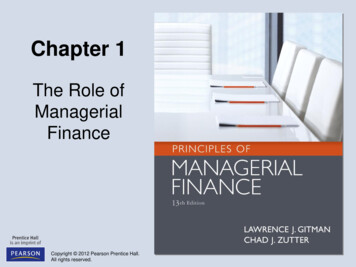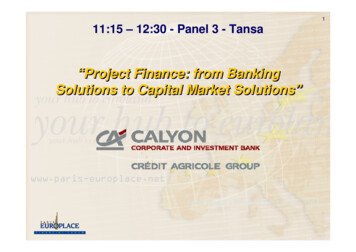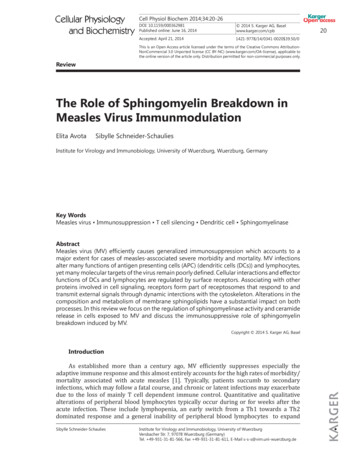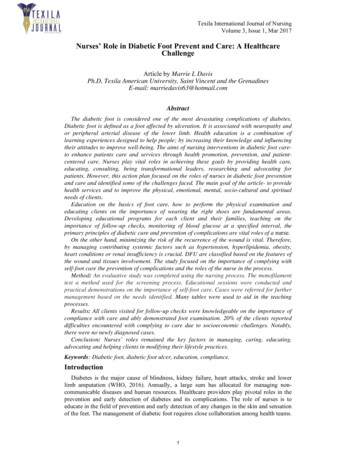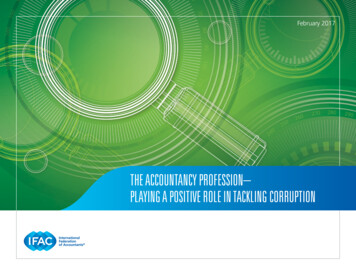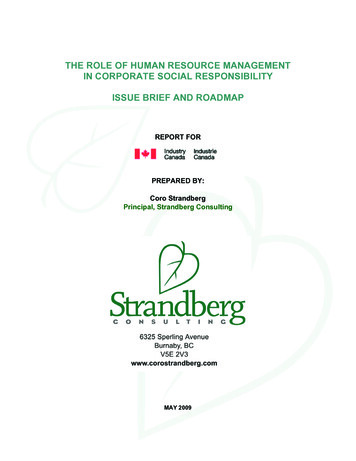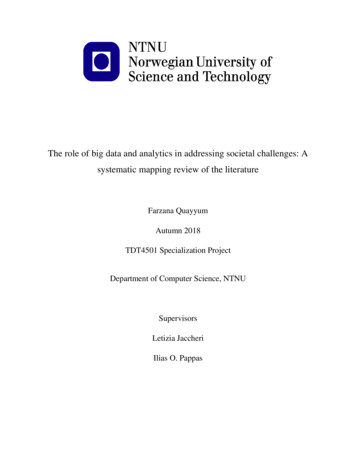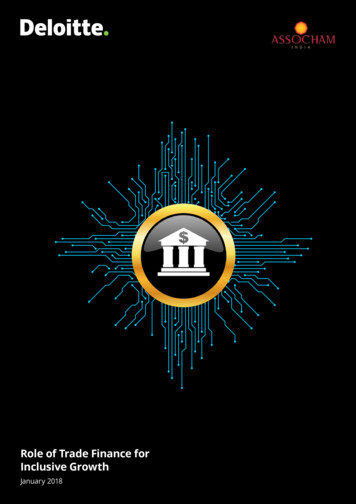
Transcription
Role of Trade Finance forInclusive GrowthJanuary 2018
Role of Trade Finance for Inclusive GrowthContentForeword by ASSOCHAM04Foreword by Deloitte05Introduction to Trade Financeand background setting06Trends in Trade Finance & Challenges12Fintech & Easing Trade Finance Norms22Revamping the Trade Financeof Domestic Demand28Glossary32About ASSOCHAM33About Deloitte34Acknowledgements3403
Role of Trade Finance for Inclusive GrowthRole of Trade Finance for Inclusive GrowthForeword byASSOCHAMForeword byDeloitteGiven the importance of Trade Financefor trade and economic growth,ASSOCHAM is organizing NationalConference on Role of Trade Finance forInclusive Growth, to tackle the issues andpromote the role of Trade Finance.DS RawatSecretary General, ASSOCHAMTrade Finance, from a Trade & Commerceperspective has assumed a greatsignificance for India especially withfalling exports to grow in the changedTrade regime, as there appears to bemore bilateralism than multilateralismin evidence. It is therefore necessaryto expand our focus on externalengagement of Trade with ourneighbours too, especially with Nepal andBangladesh, both long been one of thebest destinations of goods and services.Of late, it is under increasing pressureand competition from China.04Keeping this in context, ASSOCHAM Deloitte has brought out the knowledgepaper focusing on Trends in TradeFinance & Challenges.We hope that this study would helpthe regulators, market participants,government departments, and otherresearch scholars.Kalpesh. J. MehtaToday, with major Global economiespushing back Global trade, theirprotectionist attitude is allowing majorplayers in Asia to set themselves up asthe new champions of Globalization, andcapture the next wave of growth. Globaland Indian initiatives to drive trade mustnow be taken advantage of by India, tofully benefit from this opportunity. At thesame time, our financial system’s abilityto finance this trade is equally critical.The Trade Finance process we havein place has tremendous scope to befine-tuned and to build in efficiencies.Right from funding excess workingcapital due to lack of end-to-end visibilityon the Trade Finance lifecycle, theregulatory compliances such as KnowYour Customer (KYC) and Anti MoneyLaundering (AML) programs, there is animmediate need for some actions. Bank’schallenges aside, buyers and sellers facetheir own set of challenges due to lack ofadequate visibility on the counterparty.Small and Medium Enterprises (SMEs) /Micro-Small and Medium Enterprises(MSMEs), typically go unfinanced andget caught in a self-deprecating spiralwhere they rarely get financed by Banks,due to their own inability to provecreditworthiness. Their own preferences,emerging from proximity of the lender,are often tipped in favor of smaller, moreexpensive lenders. Worse still, they endup self-financing, which limits their abilityto grow altogether.Implementing digital technologies suchas Blockchain in Trade Finance canresolve the inefficiencies in our currentTrade Finance system, and make theprocess efficient at the Bank’s, buyer’s,seller’s, as well as the SME’s/MSME’s end.In example, Banks will avoid duplicatefinancing, buyers and sellers will avoidfraudulent trade, and SMEs/MSMEscan gain access to cheaper capitaland these inclusive businesses can bemade to scale. The Proof of Concept(PoC) stage of testing this DistributedLedger Technology (DLT) in India hasdemonstrated the application of thisDLT in Trade Finance. Challenges in itsimplementation are bound to be seen.There are also cyber, regulatory andinfrastructural implications that need tobe further deciphered.Yet, strides in Trade Finance areinevitable. The vast Trade Financeopportunity that the SMEs provide,can be explored despite the currentlimitations. With new models of creditand funding guarantees backing thetrade, the current Trade Finance processcan be changed significantly. Alternatefinancing options such as collateralfree finance and transaction financing,crowdsourcing, invoice financing forshort term finance, being examples. Onthe whole, macroeconomic indicatorsare positive and the Indian Trade Financemarket seems lucrative, if technologyis applied, data is cleaned up andGovernment actions are supportive.The Trade Finance opportunity has beenre-imagined. What the Government,banks, policy makers, regulators,buyers and sellers, need to do now is,develop strategic priorities initiatives tocollectively pursue this opportunity.05
Role of Trade Finance for Inclusive GrowthLEADS Logistics Ease Across Different StatesIntroduction toTrade Finance andbackground settingEvolution of Trade Finance: FromMaritime Trade to Block-chainTrade Finance, a commercial activity, hasbeen closely linked to the story of humantrade evolution. It has for centuriesinfluenced economic conditions, publicpolicy, living standards, and degree offinancial inclusion. The role of TradeFinance in trade is very important for usto understand, as the latter rarely takesplace safely and securely without theformer. Trade Finance, where financialinstitutions provide credit facilities suchas short-term finance to guaranteeexchange of goods (domestic andinternational), involves multiple partieson both sides of the transaction; andPayments generally through letters ofcredit (LC), or guarantees. Trade financingcould also use medium-term or long-termloans. It has evolved over the years andas of 2017, according to the World TradeOrganization (WTO), facilitated around80%1 of world trade. Innovation over theyears has helped bring efficiency andwider coverage to Trade Finance, and asboth buyers and sellers, push for greaterefficiencies, the focus on innovation islikely to further increase in 2018.The financial sector has seen manyinnovations through the years. In the1970’s, a global financial-messagingnetwork, the Society for WorldwideInterbank Financial Telecommunication(SWIFT), started out using the telex, andwas considered revolutionary. It createdthe first global financial messagingservice that used a common language forinternational financial communication.In the 1980’s, dematerialization of stocksand bonds was introduced, allowingpaperless transactions of securities.In the 1990’s, central counter partyclearinghouses helped reduce riskssuch as counterparty, settlement, anddefault risk for traders, and in the firstdecade of the twenty-first century, it wasthe application of trading systems andalgorithmic trading, bringing efficienciessuch as speed.Instruments such as receivablediscounting, pre-shipment finance andfactoring have in the past played acrucial role in the growth of internationaltrade. Today, we are again at theTrade Finance – The ContextTrade finance relates to the process of financing activities related to commerce and international trade. Companies involved withtrade finance include importers and exporters, banks and financiers, insurers and export credit agencies, and other service providers1500 BCE: ThePhoeniciansfounded maritimetransport on acommercial scale16TH CENTURY:The merchants ofVenice introducedfactoring 1World Trade Organisation: https://www.wto.org/english/thewto e/coher e/tr finance e.htm06cusp of enormous change with theadvent of digital disruption by use ofBlockchain, Artificial intelligence (AI),Machine Learning and Robotic processautomation. Banks are automatingfinancial and transactional informationexchange through pilot projects insmart contracts. Distributed ledgertechnologies (DLT) will allow stakeholdersto digitally share accurate and reliabletrade information, while smart contractssupported by DLT, will allow automatedexecution of payments on meetingpre-defined conditions in the contract.This also means that reconciliation willno longer be a worry for banks as theledger is shared and updated in realtime. Blockchain’s application for identitymanagement and know your customerlooks quite promising. Innovation inAI is also moving very fast. It too hasenormous application to solve realproblems. It could be used to detecttransactions quality, or opportunity tomarket cross channels, to ensure banksare utilizing their resources optimally.Source: Deloitte AnalysisMID-1990s: Thedawn of theinternetand ger)technology
Role of Trade Finance for Inclusive GrowthGlobal Trade Finance market reviewSize and growth trendsThe weak global economy over thelast few years has been an outcome ofpolitical uncertainty in larger economies,Brexit, sluggish growth in internationaltrade, besides other contributingfactors. However, things seem to beimproving. The year 2017 has seen globaltrade expansion as a consequence ofacceleration in global trade growth in thefirst six months of the year. The forecastin the growth of world trade volume as of21st September, 2017 was raised by theWorld Trade Organization to 3.6%2, fromthe previous 2.4%3, as of 12th April 2017.The new estimate was an improvementfrom the lacklustre 1.3% 4 growth in 2016.This strong resurgence is attributedto the revival of trade flows from Asia,especially intra-regional trade that pickedup due to recovery in demand from NorthAmerica, from the earlier 2016 figures.However, as predicted in September 2017,this high level of growth in trade volumesis expected to slow down slightly toaround 3.2%5 in 2018, owing to tighteningmonetary policy in developed economies(US), phasing out of quantitative easingin Europe, and the slowing down of easycredit, and fiscal expansion in China.Global Trade Finance’s long term growthlooks encouraging though, with anexpected CAGR of 3.77%6 (from 20162020). Global revenue from Trade Financeis expected to increase at 4.7% annually,from USD 36 billion7 in 2016, to USD44 billion in 20208. However, bankersaround the world are getting worriedabout the ability of the financial systemto deliver the financing needed to helprestore international trade as a driver ofeconomic growth. Currently, the systemRole of Trade Finance for Inclusive Growthsuffers from high cost and complexity ofcompliance. A shortage of Trade Financeis being caused due to strict compliancewith regards to know your customer(KYC) and anti-money laundering (AML)rules, to name a few.that is expected to gain traction in thecoming years. In 2015, the Renminbibypassed the Euro and the Pound tobecome the second most used currencyin trade transactions. This developmentcan be attributed directly to the effortof the Government of China to promoteits currency by setting up global clearingcenters for conversion and settlementsin Renminbi.Continuing shift in regional tradeactivity and implication on TradeFinanceOn a global scale we are also witnessinga shift in the geo-political center awayfrom the United States of America, asChina, Japan step up. In 2017 we sawa backlash in trade on a global scaleas Governments around the worldimplemented protectionist economicpolicies and tore down trade agreements.The recent pulling away from the TransPacific Partnership (TPP) and threats ofleaving the North American Free TradeAgreement (NAFTA), are clear signsthat the USA is changing tracks and hasmoved away from its position as globalhead of liberal trade policy and hasadopted an “America First” approach.Its focus has shifted from multilateralto bilateral trade deals. This has set upother major players as the champions ofglobalization to capture the next waveof growth. The European Union (EU) isalso seeing growing uncertainty. WithBritain’s referendum to leave the EU, ithas brought about the question of EU’sstability.Trade Facilities and an overview oftrade facilitation measuresWorld Trade Facilities Agreement (TFA) –was signed to address red tape in trade.The agreement expedites the movementof goods, by making the trading processsimple and modern. It also sets outeffective co-operation measures betweenauthorities on trade facilitation, includingcustoms. The agreement becameeffective in February 2017. Till December2017, 1219 WTO members have ratifiedthe agreement. According to the WTO, theTFA’s full application is expected to cutmember’s costs of trade by an averageof 14.3%10. The TFA is also likely to reducethe time needed to export goods by over2 days, and import various goods by over1.5 days. This will represent a reduction intime of 47%11 and 91%12 respectively overthe current average. Moreover, with thefull implementation of the agreement,the number of new products exportedby developing countries is expected toincrease by as much as 20%13, and theleast developed economies are likely tosee an increase of over 35%14. This wouldboost global trade by up to USD 1 trillionannually, the biggest impact being felton poorer countries. Trade FacilitationChina on the other hand has made tradegrowth a priority, and it is an area wherethe world is investing heavily. The Beltand Road is key to China’s growth, aswell as a possible solution to the currentuncertain and sluggish global tradeenvironment. The rise in the count ofRenminbi backed transactions is a trendAgreement Facility (TFAF), effectiveNovember 2014, is the TFA facility whichensures assistance to lesser developedcountries to benefit from the TFA.Indian Trade Finance market reviewIndian trade comprises domestic (intraregional) and cross border trade.Size and growth trends in domesticdemandIndia’s slow growth in trade hasbeen a case of concern. Many, areattributing this short term down turnas a negative fallout from the reforms Demonetization and Goods and ServiceTax (GST). India’s trade deficit hit a 35month high, at USD 14 billion15 as exportsdeclined, for the first time in 14 monthsby 1.12%16 in October 2017, to USD 23.1billion.17 Exporters faced a liquiditycrunch after paying GST for four monthsin a row without any refund.Implications of Government initiativeson TradeIndia currently ranks 100 in ease of doingbusiness. Government initiatives haveplayed a big role in improving the easeof doing business ranking from the 2016rank of 13018. Yet, a lot of work is still to bedone. Given that, India significantly lagson key metrics such as: turn-around timeand operating costs, reliance on physicaldocumentation, requirement of liaisonwith multiple stakeholders on disparatesystems and lack of transparency,increase the cost of compliance. Theselimitations, limit trading volumes, whichin turn limit the speed and efficiency ofTrade Finance.Ratification list, World Trade Organisation: http://www.tfafacility.org/ratificationsWTO’s Trade Facilitation Agreement enters into force, World Trade Organisation, 22nd February 2017: https://www.wto.org/english/news e/news17 e/fac 31jan17 e.htm11WTO’s Trade Facilitation Agreement enters into force, World Trade Organisation, 22nd February 2017: https://www.wto.org/english/news e/news17 e/fac 31jan17 e.htm12WTO’s Trade Facilitation Agreement enters into force, World Trade Organisation, 22nd February 2017: https://www.wto.org/english/news e/news17 e/fac 31jan17 e.htm13WTO’s Trade Facilitation Agreement enters into force, World Trade Organisation, 22nd February 2017: https://www.wto.org/english/news e/news17 e/fac 31jan17 e.htm14WTO’s Trade Facilitation Agreement enters into force, World Trade Organisation, 22nd February 2017: https://www.wto.org/english/news e/news17 e/fac 31jan17 e.htm15India’s Foreign Trade, Press Information Bureau, October 2017: http://pib.nic.in/newsite/PrintRelease.aspx?relid 17349916India’s Foreign Trade, Press Information Bureau, October2017: http://pib.nic.in/newsite/PrintRelease.aspx?relid 17349917India’s Foreign Trade, Press Information Bureau, October2017: http://pib.nic.in/newsite/PrintRelease.aspx?relid 17349918World Bank, Ease of business rankings: http://www.doingbusiness.org/rankings910World Trade Organisation: https://www.wto.org/english/news e/pres17 e/pr800 e.htmWorld Trade Organisation: https://www.wto.org/english/news e/pres17 e/pr800 e.htm4World Trade Organisation: https://www.wto.org/english/news e/pres17 e/pr800 e.htm5World Trade Organisation: https://www.wto.org/english/news e/pres17 e/pr800 e.htm6Business wire, 10th October 2016: 77ICC Global Survey on Trade FinanceTrade Finance 2017, International Chamber of Commerce (ICC), Pg 56, e-finance/8ICC Global Survey on Trade FinanceTrade Finance 2017, International Chamber of Commerce (ICC), Pg 56, e-finance/230809
Role of Trade Finance for Inclusive GrowthThe Government has been drivinginitiatives to stimulate trade: Foreign Trade Policy (FTP) is expectedto be crucial to the growth of theeconomy. This policy provides astrong foundation and a viable policyenvironment to conduct internationaltrade. Launched in April 2015, the FTP2015-2020 has helped improve themeasures used for trade facilitation. Itprovides a structure for boosting goodsand services trade, while at the sametime also generating employment.While consolidating existing exportincentive schemes, the policy hasintroduced two more schemes:–– ‘Merchandise Exports from IndiaScheme’ (MEIS). This schemefacilitates the export of statedgoods to stated markets, and–– ‘Services Exports from IndiaScheme’ (SEIS). This scheme servesthe purpose of increasing exportsof declared services. It benefits allservice providers (providing servicesfrom India), regardless of theprovider’s profile.Some other features of the policyinclude coupling procedures andincentives with other Governmentinitiatives such as “Make in India”,“Digital India” and “Skills India”. Make in India – The campaign aims tochallenge the way the Indian economycurrently functions. The scheme wasput in place to help turn India into aglobal manufacturing destination, andincrease manufacturing’s share in GrossDomestic Product (GDP) to 25%20 by2025, from 16% in 201721. The state of Infrastructure hasdrastically improved post 2014 whenthe Government increased publicRole of Trade Finance for Inclusive Growth Export Data Processing and MonitoringSystem (EDPMS) – A comprehensive ITsystem launched by the Reserve Bankof India (RBI) for the monitoring ofexport of goods and software and helpbanks report returns through a singleplatform, for better monitoring andintegrating returns.spending and sped up the approvalprocess in order to attract privatefunds and resources. Fueled by variousreforms, infrastructure growth canin-fact be expected across sectors.“BharatMala”, the road ministry’s planto build 5,000 KM of roads costingINR 12,000 crore in 2 years fromGujarat to Mizoram, and covering10 border hugging states, is likely tofacilitate trade with neighbors in theregion. The growth in trade volumeswill further increase the need forinfrastructure financing. Improvementin infrastructure is expected tohelp attract FDI as well. The TradeInfrastructure for Exports Sector (TIES)is a scheme being designed to supportinfrastructure projects linked toexports. Import Data Processing and MonitoringSystem (IDPMS) – The Reserve Bankof India came out with a format to befollowed by banks for Bill of Entry22reporting under IDPMS. This move isaimed to boost ease of doing business,as well as facilitate efficient dataprocessing for payment of importtransactions. The scheme “Assistance to States forDevelopment Export Infrastructureand Allied Activities (ASIDE)”, was putin place to create export infrastructurethrough the most efficient utilizationof resources. This would help meetthe laid down growth in exports viaa coordinated effort of the State andCentral Governments. The Governmentspent INR 2,50023 crore in the 10th Fiveyear plan (2002-2007) and INR 3,04824crore in the eleventh five year plan(2007-2012) under the scheme. RBI’s Trade Receivables DiscountingSystem (TReDS) is an interestingexample of how digitization is helpingMicro Small and Medium Enterprises"before (MSME) get access to easycapital, by auctioning their receivables.TReDS is an electronic
Sep 21, 2017 · factoring have in the past played a crucial role in the growth of international trade. Today, we are again at the cusp of enormous change with the advent of digital disruption by use of Blockchain, Artificial intelligence (AI), Machine Learning and Robotic process automation. Ban
